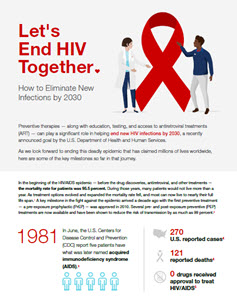Eliminating new HIV infections by 2030
Preventive therapies are key to ending the AIDS epidemic
Sree Chaguturu, MD, Executive Vice President & Chief Medical Officer

In the beginning of the HIV/AIDS epidemic — before the drug discoveries, antiretroviral, and other treatments — the mortality rate for patients was 95.5 percent. During those years, many patients would not live more than a year. As treatment options evolved and expanded the mortality rate fell, and most can now live to nearly their full life span.1 A key milestone in the fight against the epidemic arrived a decade ago when the first preventive treatment — a pre-exposure prophylactic (PrEP) — was approved in 2010. Several pre- and post-exposure preventive (PEP) treatments are now available and have been shown to reduce the risk of transmission by as much as 99 percent.2
Preventive therapies — along with education, testing, and access to antiretroviral treatments (ART) — can play a significant role in helping end new HIV infections by 2030, a recently announced goal by the U.S. Department of Health and Human Services.
As we look forward to ending this deadly epidemic that has claimed millions of lives worldwide, here are some of the key milestones so far in that journey.

Looking Ahead to 2030
Much remains to be done and ending new HIV infections by 2030 — and therefore the epidemic — will take a concerted effort by a range of stakeholders. Along with helping create awareness and ensuring easy, affordable access to treatment, preventing transmission through use of PrEP and PEP treatments will be an important component of meeting that goal.
This document contains references to brand-name prescription drugs that are trademarks or registered trademarks of pharmaceutical manufacturers not affiliated with CVS Health.
Data source, unless noted otherwise, CVS Health Enterprise Analytics, 2020.
Image source: Licensed from Getty Images, 2020.